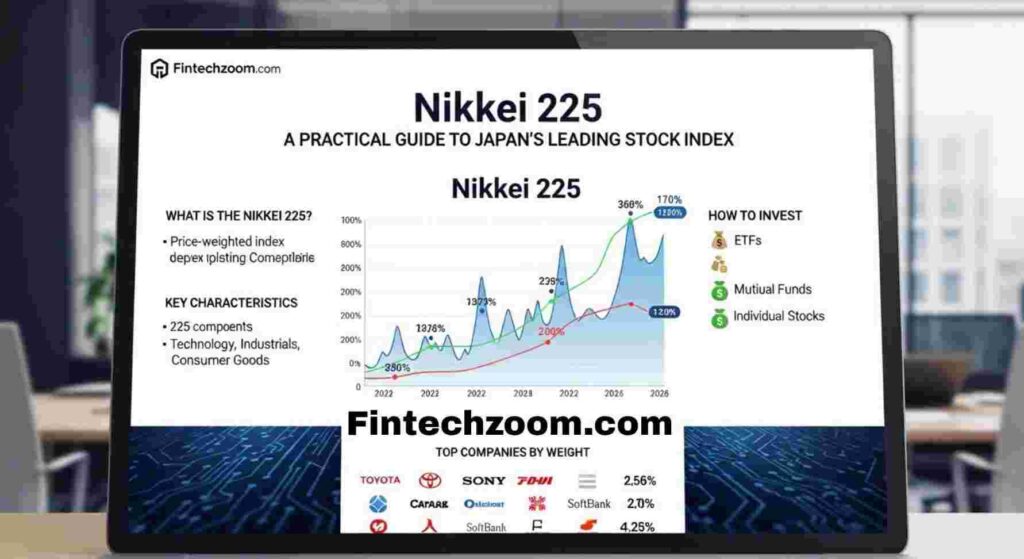Understanding global stock markets can feel overwhelming. But if you’re an investor, trader, or even a casual market watcher, it’s crucial to know what drives key indices like the Nikkei 225—especially when platforms like FintechZoom.com offer detailed insights into their daily performance. Whether you’re looking to diversify into Asian equities or simply want to decode Japan’s market pulse, this article breaks down everything you need to know about the Nikkei 225 through the lens of FintechZoom’s 2025 market coverage.
What Is the Nikkei 225? Japan’s Economic Barometer
Before diving into FintechZoom’s coverage, let’s first clarify what the Nikkei 225 actually represents. Often compared to the Dow Jones Industrial Average in the U.S., the Nikkei 225 is Japan’s premier stock index. It tracks the performance of 225 large, publicly traded Japanese companies listed on the Tokyo Stock Exchange (TSE).
A Snapshot of Economic Heavyweights
These 225 companies span multiple sectors, including:
-
Technology: Sony, SoftBank Group, and Tokyo Electron
-
Automotive: Toyota, Honda, Nissan
-
Financials: Mitsubishi UFJ Financial Group, Nomura Holdings
-
Consumer Goods: Fast Retailing (owner of Uniqlo), Kao Corporation
In essence, the Nikkei 225 is a direct reflection of Japan’s corporate health and broader economic trends.
Why Investors Track It
Investors globally monitor the Nikkei because:
-
Japan is the world’s third-largest economy.
-
Many Nikkei-listed companies have significant international footprints.
-
It offers a window into global supply chains, especially in tech and automotive sectors.
How It’s Calculated
Unlike some market-cap weighted indices (like the S&P 500), the Nikkei 225 is price-weighted. That means higher-priced stocks have more influence, regardless of a company’s actual size. This often creates a unique composition compared to other indices.
How FintechZoom.com Tracks and Analyzes the Nikkei 225
So where does FintechZoom.com come in?
In 2025, FintechZoom has emerged as one of the more dynamic platforms for retail investors and financial enthusiasts. Their Nikkei 225 coverage stands out due to a few key features.
Real-Time Data With Context
FintechZoom.com provides near real-time updates on Nikkei 225 performance, including:
-
Daily percentage movements
-
Individual stock gainers and losers
-
Sector-specific trends within the index
But more importantly, it goes beyond raw data. The platform regularly includes:
-
Contextual analysis of major swings
-
Breaking news affecting specific stocks
-
Sentiment from local and international markets
Visual Dashboards for User-Friendly Monitoring
One of FintechZoom’s strong suits is its clean, easy-to-use dashboards. For Nikkei 225, you’ll often find:
-
Line and candlestick charts with timeframes from 1 day to 5 years
-
Comparative analysis between the Nikkei, TOPIX, and other global indices
-
Heatmaps showing sector performance within the 225 components
Expert Commentary That Adds Value
FintechZoom features regular market commentary from Japanese and global analysts. You’ll find insights on:
-
The impact of BOJ (Bank of Japan) monetary policy decisions
-
The influence of yen movements on exporters like Toyota or Canon
-
Domestic factors like inflation data, GDP updates, or consumer sentiment
Their multilingual content also helps bridge the information gap for international users seeking to understand Japanese markets.
Key Nikkei 225 Trends in 2025 Worth Watching
1. BOJ’s Policy Shift is Shaking Things Up
Since late 2024, the Bank of Japan has been gradually moving away from its ultra-loose monetary policy. The interest rate environment has started to shift upward, which has two major consequences:
-
Stronger Yen: This impacts major exporters by making their products more expensive overseas.
-
Financial Sector Growth: Banks and insurance companies listed on the Nikkei have seen rising stock prices due to higher interest income potential.
FintechZoom’s real-time analysis highlights how these dual forces create a push-pull effect on the index.
2. AI and Robotics Boom Boosts Tech Stocks
Japan’s global leadership in robotics and automation is fueling a resurgence in tech stocks. Companies like Fanuc, Keyence, and Tokyo Electron have surged in value in early 2025, thanks to:
-
Increased demand for automation tools globally
-
AI integration across manufacturing
-
FintechZoom reports show double-digit quarterly gains for these players
3. Supply Chain Recovery Post-COVID
Although COVID-19 is largely in the rearview mirror, its aftershocks on supply chains are still being resolved. Japan’s automotive and electronics sectors have shown significant rebound patterns, as highlighted in FintechZoom.com nikkei 225 analysis. Toyota’s return to full production capacity and stable chip supplies are key reasons behind the index’s bullish movements this year.
Comparative Table: Nikkei 225 vs Global Indices (2025)
| Index | Region | YTD Performance (as of July 2025) | Key Drivers |
|---|---|---|---|
| Nikkei 225 | Japan | +12.4% | Tech growth, BOJ rate policy |
| S&P 500 | U.S. | +9.6% | AI stocks, Fed hold |
| FTSE 100 | U.K. | +6.3% | Energy, commodities |
| DAX | Germany | +10.2% | Industrial recovery |
| Hang Seng | Hong Kong | +4.8% | Policy easing, property rebound |
Source: FintechZoom.com and Reuters, July 2025
Investing in the Nikkei 225: Tips and Tools
If you’re looking to gain exposure to Japan’s stock market, here are a few ways FintechZoom recommends approaching it:
Use ETFs to Minimize Risk
ETFs like the iShares Nikkei 225 ETF (Tokyo: 1329) or MAXIS Nikkei 225 (Tokyo: 1346) allow for broad exposure without needing to pick individual winners. They are also available on some global trading platforms.
Watch the Yen
Currency swings can significantly affect returns for foreign investors. A weaker yen can boost Japanese exporters, but may also impact your investment returns when converted back into your home currency.
FintechZoom frequently includes currency overlays and forex projections alongside its Nikkei coverage.
Keep an Eye on Regional Geopolitics
From trade tensions to regional security issues, Asia’s political climate plays a role. Recent FintechZoom briefings have noted the Nikkei’s sensitivity to:
-
Taiwan Strait tensions
-
China-Japan trade data
-
U.S. military commitments in the Pacific
What Sets FintechZoom.com Apart in 2025
Unlike traditional financial portals, FintechZoom isn’t just about price tracking. It’s a curated ecosystem for investors who want depth without clutter. Here’s what makes it special:
-
Daily curated news summaries with actionable takeaways
-
In-browser alerts for volatility spikes on indices like the Nikkei
-
Interactive tools such as simulated investment portfolios with Nikkei 225-based holdings
-
Community engagement through comment sections and forums
It’s become a go-to for both novice and seasoned investors who want to keep tabs on Japan’s market without wading through walls of outdated data.
Conclusion: Why FintechZoom.com Nikkei 225 Should Be on Your Radar
The Nikkei 225 isn’t just a Japan-centric index—it’s a mirror of global supply chains, innovation, and investor sentiment across Asia. In 2025, with tech surges, policy pivots, and an evolving global economic landscape, staying informed is no longer optional. Platforms like FintechZoom.com make that easier, offering timely data, sharp insights, and user-centric tools for tracking the Nikkei 225 like a pro.
Whether you’re an investor, analyst, or someone exploring international markets, understanding the FintechZoom.com Nikkei 225 landscape will give you the edge you need to make better, smarter financial decisions.
FAQs About FintechZoom.com Nikkei 225
Q1: Is FintechZoom.com a reliable source for Nikkei 225 updates?
Absolutely. FintechZoom sources real-time financial data from trusted aggregators and combines that with expert insights. For retail traders and casual investors, it’s an accessible and accurate resource.
Q2: Can I invest in the Nikkei 225 directly from the U.S. or Europe?
Yes, through ETFs that track the Nikkei 225. FintechZoom often lists these funds and provides region-specific broker guides.
Q3: Does FintechZoom offer alerts for big movements in the Nikkei 225?
Yes. You can set up browser-based notifications or email alerts when major changes or news events affect the index.
Q4: Why does the Nikkei 225 move differently from the S&P 500?
Different economic environments, central bank policies, and sector compositions explain this. Japan’s index is more weighted toward manufacturing and tech hardware, while the S&P 500 leans heavily into U.S.-based tech and services.
Q5: How does the Yen affect Nikkei 225 stocks?
A strong yen often weighs on exporters, reducing overseas earnings. Conversely, a weaker yen boosts profits for international sales. FintechZoom frequently ties currency changes to stock performance.
Q6: Is FintechZoom free to use?
Most of its core features are free, though there are premium tiers offering advanced charting, in-depth research, and ad-free access.



